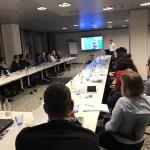On 16th May 2017, 35 senior finance practitioners joined the fourth meeting of the Geneva FP&A...
 Awareness of the simple errors that are present in our (and others) thinking aka cognitive biases is an important component of critical thinking.
Awareness of the simple errors that are present in our (and others) thinking aka cognitive biases is an important component of critical thinking.
This article highlights some of the common cognitive biases that I have come across in my career and how awareness and mitigation of these could lead to our becoming better finance business partners.
Authority Bias
Budgeting meetings where the group agrees with a market growth assumption made by a senior sales leader without much debate? This could be the authority bias at play. It is the tendency to attribute greater accuracy to the opinion of an authority figure. Provides an excellent opportunity for finance to come prepared with data to the decision table, challenge key assumptions and ensure the right business decisions are made. Your business leaders will thank you for it.
Forecasting Bias and the Illusion of Control
Relying on an external or internal “expert's” prediction/report to model your business case? Patting yourself on the back for an accurate revenue forecast? Watch out-two things could be at play. One is the tendency to accept an expert’s opinion as right aka forecasting bias. The other is having an illusion of control over a very difficult process i.e. forecasting.
Have found the following to help mitigate the impact of the above biases:
- Accept an expert's prediction at face value. Have a point of view on the prior track record of predictive accuracy.
- Focus more on the robustness of the forecasting process that led to the outcome rather than the outcome itself.
- If you are in a regional consolidation role, be aware of the “forecasting personalities” of the different regions and adjust your consolidated forecast for the optimists and conservatives.
Anchoring Bias
Quick exercise. Estimate how higher or lower than 75 meters is the world’s tallest weeping willow tree. Jot it down. If your estimate is in the absolute range of 0-30 meters you have fallen prey to the anchoring bias i.e. a tendency to rely too much on an initial value while making decisions. The world’s tallest weeping willow tree is only 14 meters and getting an estimate close to this value will require us to completely ignore the initial value of 75 meters.
Mitigation? Keep in mind the willow tree example when given an initial piece of information. Use tools like Zero Based Budgeting to get cost structure estimates right.
Omission Bias
You come across a newspaper article about a fire in the neighborhood that was set off by an arsonist. Onlookers did not do much to douse the fire or alert the authorities. Who would you judge as guilty, the arsonist or the onlookers? If you judge the arsonist more harshly you have fallen prey to the omission bias i.e. the tendency to judge harmful action as worse than equally consequential inaction.
Mitigation? When you see a business scenario unfold that needs correction (for example an approved business case that is not being implemented as planned), assume responsibility and take actions towards resolving it rather than justify your inaction on the grounds that it is not in your scope, etc. That would ensure you are part of the solution and progressing well towards becoming an effective finance business partner.
References and recommended reads
- "Thinking, Fast and Slow" by Daniel Kahneman
- "The art of thinking clearly" by Rolf Dobelli
- "Critical thinking" by Linda Elder and Richard Paul
Subscribe to
FP&A Trends Digest

We will regularly update you on the latest trends and developments in FP&A. Take the opportunity to have articles written by finance thought leaders delivered directly to your inbox; watch compelling webinars; connect with like-minded professionals; and become a part of our global community.



